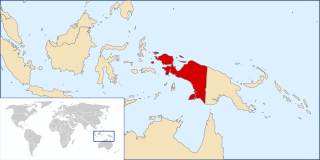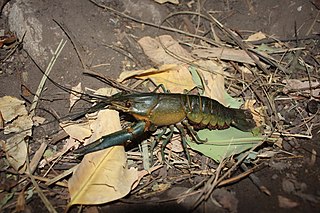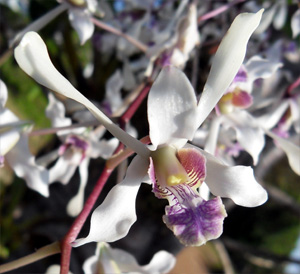
Western New Guinea, also known as Papua, is the western portion of the island of New Guinea controlled by Indonesia since 1962. Since the island is alternatively named as Papua, the region is also called West Papua. Lying to the west of Papua New Guinea, it is the only Indonesian territory situated in Oceania. Considered to be a part of the Australian continent, the territory is mostly in the Southern Hemisphere and includes the Schouten and Raja Ampat archipelagoes. The region is predominantly covered with ancient rainforest where numerous traditional tribes live such as the Dani of the Baliem Valley although a large proportion of the population live in or near coastal areas with the largest city being Jayapura.

Cherax, commonly known as yabby/yabbies in Australia, is the most widespread genus of fully aquatic crayfish in the Southern Hemisphere. Various species of cherax may be found in both still and flowing bodies of freshwater across most of Australia and New Guinea. Together with Euastacus, it is also the largest crayfish genus in the Southern Hemisphere.

Cherax quadricarinatus is an Australian freshwater crayfish.

The common yabby is an Australian freshwater crustacean in the Parastacidae family. It is listed as a vulnerable species of crayfish by the International Union for Conservation of Nature (IUCN), though wild yabby populations remain strong, and have expanded into new habitats created by reservoirs and farm dams.

Pelvicachromis pulcher is a freshwater fish of the cichlid family, endemic to Nigeria and Cameroon. It is popular amongst aquarium hobbyists, and is most commonly sold under the name kribensis, although it has other common names, including various derivatives and color morphs of the kribensis: krib, common krib, red krib, super-red krib and rainbow krib, along with rainbow cichlid and purple cichlid.

Amphilophus labiatus is a large cichlid fish endemic to Lake Managua and Lake Nicaragua in Central America. It is also known by the common name red devil cichlid, which it shares with another closely related cichlid, A. citrinellus.

The chestnut-breasted mannikin, also known as the chestnut-breasted munia or bully bird, is a small brown-backed munia with a black face and greyish crown and nape. It has a broad ferruginous breast bar above a white belly. The species is found in Australia, New Caledonia, Indonesia, and Papua New Guinea. This species has also been introduced to French Polynesia and France.
Bleher's rainbowfish is a species of rainbowfish in the subfamily Melanotaeniinae. It is named in honor of Heiko Bleher, a German botanist and ichthyologist.
Cherax parvus is a species of crayfish in the family Parastacidae. It is only known from its type locality – the Upper Tully River catchment in the Cardwell Range of north-eastern Queensland – and is listed as data deficient on the IUCN Red List. It was discovered in a rainforest catchment in a highland of northeastern Queensland during a Queensland Museum expedition to the upper Tully River area in November 1992. It is one of the smallest species in the genus. No species of Cherax has been considered endemic to wet upland or highland areas before it was discovered; most previous records were from elevations less than 400 meters. It also has several morphological features unique to the genus, and does not appear closely related to any extant species, suggesting a long period of geographic isolation.

New Guinea is the world's second-largest island, and with an area of 785,753 km2 (303,381 sq mi), the largest island in the Southern Hemisphere. Located in Melanesia in the southwestern Pacific Ocean, it is separated by the 150 km wide Torres Strait from Australia. Numerous smaller islands are located to the west and east. The eastern half of the island is the major land mass of the independent state of Papua New Guinea. The western half, known as Western New Guinea or West Papua, forms a part of Indonesia and is organized as the provinces of Papua and West Papua.

The redside barb or two-spot barb is a species of ray-finned fish in the genus Puntius. It is found in India and Sri Lanka. It was identified and classified by Pieter Bleeker in 1863.
Toxotes lorentzi is a tropical freshwater fish found in streams and swamps of the Northern Territory of Australia, Irian Jaya (Indonesia), and Papua New Guinea. It was first named by Weber in 1910, and is commonly known as the primitive archerfish or Lorentz's archerfish.

The Ayamaru Lakes are a group of lakes found in the west-central part of the Bird's Head Peninsula in West Papua, Indonesia. The lakes are named after the Ayamaru people that lived here for thousands of years. The nearest village to the group is Greemakolo. The many villages around the Ayamaru Lakes started the Ayamaru language.

The Paniai Lakes, originally known as the Wissel Lakes, are the three large, freshwater lakes in the central highlands of Papua, Indonesia: Paniai, Tigi, and Tage. Lakes Paniai and Tage are located in the Paniai Regency, while Lake Tigi is located in Deiyai Regency. The largest of the three is Lake Paniai, while its immediate neighbor Lake Tage is the smallest.
Cherax holthuisi is a species of crayfish from the Bird's Head Peninsula in New Guinea. It grows to a total length of 81–93 mm (3.2–3.7 in) and is typically pink, orange or yellow in wild specimens. It was described in 2006 after animals circulating in the aquarium trade could not be assigned to any known species.

Dendrobium lineale is a species of orchid. It is an epiphytic plant that grows along the north-eastern coast of New Guinea, from Milne Bay to just over the border into the Indonesian Province of Papua, and from sea level to around 800 metres (2,600 ft). It has cane-like pseudobulbs which grow up to 2 metres long and 2–3 centimetres (0.8–1.2 in) in diameter. Its inflorescences are up to 75 cm (30 in) long with many flowers, up to 5 cm (2.0 in) across. Its leaves are oblong or lanceolate, and up to 15 cm (6 in) long. They last two to three months and bloom throughout the year in the native habitat.

The eastern swamp crayfish is a species of small freshwater crayfish from coastal New South Wales, Australia. It is distinguished from related species by large genital papilla on the males, large raised postorbital ridges, a laterally compressed carapace, and elongated chelae.

Pelvicachromis sacrimontis is a freshwater fish of the cichlid family known only from a small area of southeastern Nigeria.Currently Fishbase considers this binomial to be a junior synonym of P. pulcher and, it was also known as Pelvicachromis camerunensis, P. pulcher "form B" or P. sp. aff. pulcher but some authorities now consider it to be a valid species. It is occasionally available in the tropical fish trade as "giant krib" and there are three colour morphs – red, green and yellow.

Cherax snowden is a species of crayfish from West Papua in Indonesia. In the wild, they live in freshwater river tributaries. It is popular as a freshwater aquarium pet across Asia, Europe, and North America because of its orange-tipped claws. Specimens were previously misidentified as members of Cherax holthuisi, also from West Papua.

Glossolepis dorityi, the Grime rainbowfish, is a species of rainbowfish native to the Grime River region in northern West Papua.
















